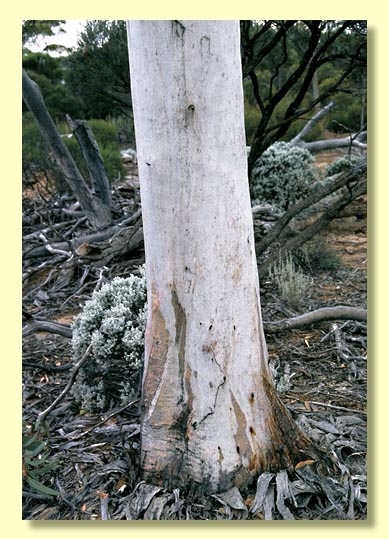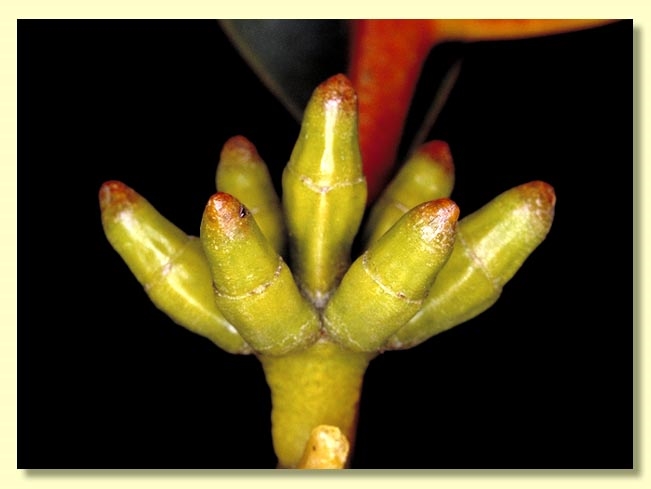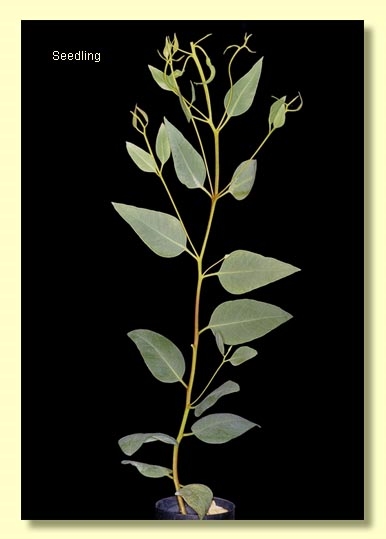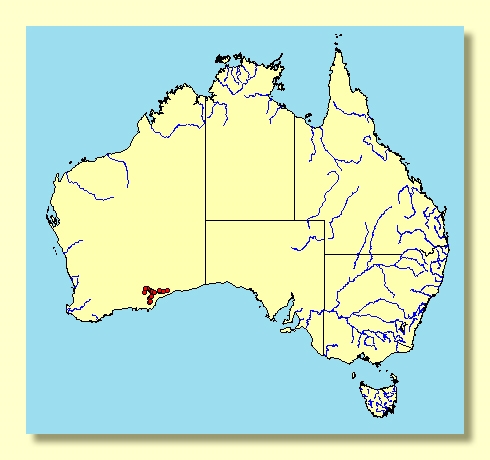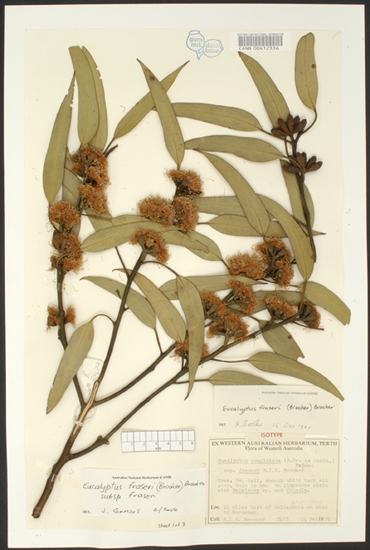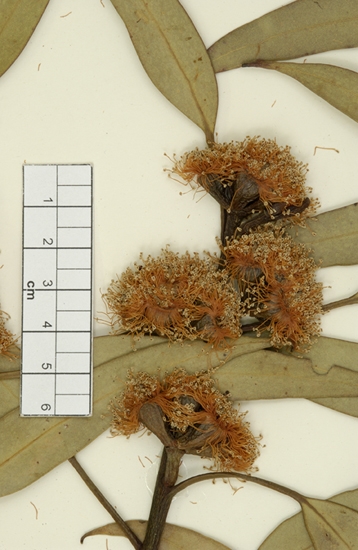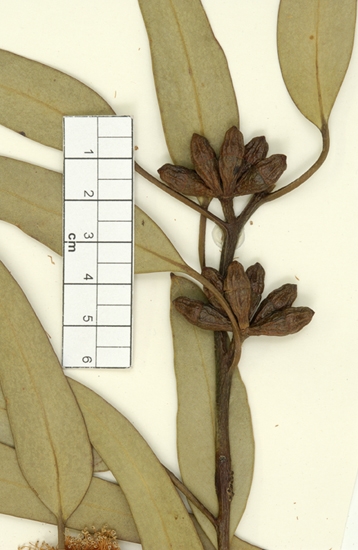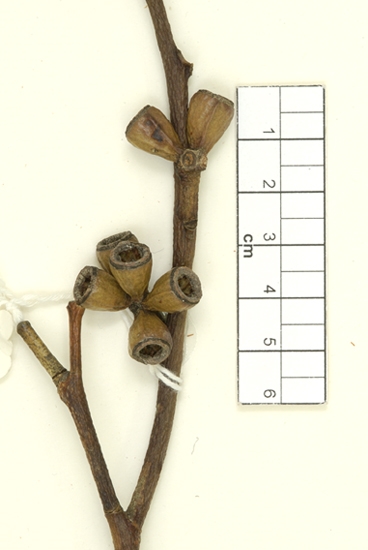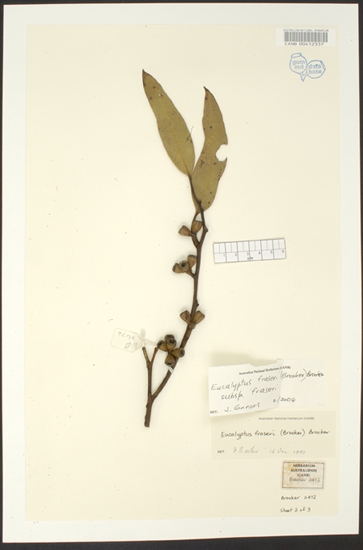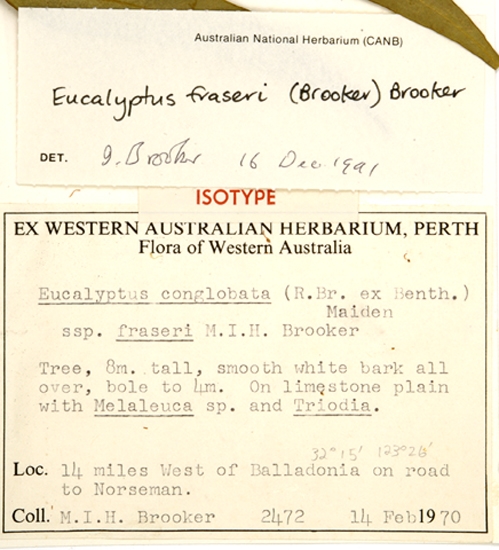Euclid - Online edition
Eucalyptus fraseri subsp. fraseri
Eucalyptus | Symphyomyrtus | Dumaria | Rufispermae
Bark smooth grey to creamy white over orange shedding in long ribbons.
Branchlets with oil glands in pith.
Juvenile growth (coppice or wild seedling to 50 cm tall): stems square to rounded in cross-section, glaucous; juvenile leaves always petiolate, alternate, deltoid to ovate, 7.5–10.5 cm long, 3.5–6.5 cm wide, base truncate to rounded or tapering, dull, bluish-green to glaucous.
Adult leaves thick, leathery, alternate, petioles 1.5–3.3 long; blade, lanceolate or falcate, 9–17 cm long, 1.3–3.5 cm wide, base tapering, margin entire, apex pointed, concolorous, bluish green maturing glossy, green, side-veins at an acute or wider angle to midrib, reticulation dense to very dense, intramarginal vein close to margin, numerous intersectional oil glands.
Inflorescence axillary unbranched, peduncles stout, 0.5–1 cm long, buds 7 or 9 per umbel, shortly and stoutly pedicellate or sessile, pedicels 0–0.3 cm long. Mature buds ovoid (1–1.5 cm long, 0.6–0.7 cm wide), scar present, operculum conical and often radially striate (0.6–0.9 cm long), stamens inflexed, anthers cuboid to wedge-shaped, versatile, sub-basifixed, dehiscing by longitudinal slits, style long, straight, stigma more or less rounded, locules 4, the placentae each with 4 vertical rows of ovules. Flowers white.
Fruit pedicellate or rarely sessile (pedicels 0–0.3 cm long), slightly elongated-cupular, 0.7–1.1 cm long, 0.7–1 cm wide, with 2-many shallow longitudinal striations, disc descending obliquely, valves 4, near rim level.
Seeds reddish brown and glossy, 0.6–3 mm long, flattened-ovoid and slightly angular, dorsal surface sometimes lacunose, scarcely reticulate, hilum ventral.
Cultivated seedlings (measured at ca node 10): cotyledons reniform; stems square in cross-section; leaves always petiolate, opposite for 3 or 4 nodes then alternate, deltoid to ovate, 4.5–9 cm long, 3–6 cm wide, dull, grey-green to green.
Flowering has been recorded in April.
Eucalyptus fraseri is a small to medium-sized tree (mallet) species with coarse-leaved glossy green crown, endemic to arid south-eastern Western Australia from the Fraser Range extending to the east and south of Balladonia.
In the classification of Brooker (2000) Eucalyptus fraseri belongs in Eucalyptus subgenus Symphyomyrtus section Dumaria having these features: buds initially with two opercula the outer shed early, stamens strongly inflexed, ovules in 4 rows on the placentae and cotyledons reniform. Within section Dumaria the species belongs to a large sub-group of closely related species (series Rufispermae, 37 described species and subspecies) diagnosed by glandular pith in the branchlets, anthers cuboid to wedge-shaped, versatile, and by the reddish brown and glossy, flattish seeds which are unique to the series.
E. fraseri is a prominent, erect tree with relatively large buds and fruit, and juvenile leaves which are large, deltoid, and slightly glaucous. It is closest to the recently described E. valens from near Scadden south-west of the distribution of E. fraseri and which differs by having completely sessile buds and fruits and a more squat operculum. To the east of the distribution of E. fraseri, the related E. calcareana is found, extending well into South Australia, and differs from E. fraseri by the smaller stature, and smaller buds and fruits, and by having a lignotuber. The mallet E. georgei subsp. georgei grows with E. fraseri and is distinguished from the latter by dull slightly glaucous adult leaves, glaucous branchlets, buds and fruit.
There are two subspecies:
E. fraseri subsp. fraseri
A graceful white-barked tree growing in the dry country from the eastern slopes of Fraser Range to Balladonia and to the south thereof on sandy red loams.
E. fraseri subsp. melanobasis
This is a localized tree with a distinct rough black lower trunk; restricted to the upper parts of the Fraser Range, but the limits of its distribution away from highway 1 are not clear.


